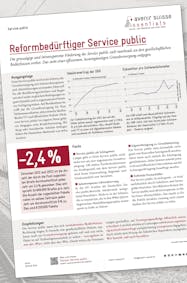Old age care is a matter of concern for today’s young people. By 2035, the proportion of the very elderly (80+) relative to the working population will have soared by 70%. Our seventh “Cantonal Monitoring” report looks at the provision of old age care in Switzerland’s 26 cantons. We estimate annual savings of SFr1.9bn a year are possible if every canton worked as efficiently as at least the national average. Realising the full potential requires a holistic approach that doesn’t look only at costs, but at organisation and financing too.
Public debate about our ageing society is dominated by concerns about pensions. But the question of old age care urgently requires more attention too. By 2035, the share of people aged 80 and above relative to the active population will have increased by 70% – and by up to 150% depending on canton. By 2045, estimates suggest spending on this increasingly crucial social duty will double – to no less than 3.4% of gross domestic product.
For Avenir Suisse’s seventh “Cantonal Monitoring” report, Senior Fellow Jérôme Cosandey has interviewed the heads of relevant cantonal authorities and crunched the numbers to show how cantons organise old age care, along with their cost structures and financing. As his title suggests, the author calls for “New Measures for Old Age Care”, and shows how cantons, in the best spirit of federal competition, can learn from each other.
Looking at organisation holistically
In a federal state, differing cultural views and values lead inevitably to disparities in how old age care is organised. Cantons in French speaking Switzerland have fewer beds in care homes for the over 80s, but an above average number of Spitex staff. ((Spitex is the Swiss system of outpatient old age care provision, ed)). Higher Spitex staffing alone doesn’t necessarily lead to fewer beds in care homes. Additional supply could simply boost demand.
Nor is Spitex always the cheapest route for looking after the elderly. Depending on the setting, patients can – after the first 60 minutes – be cared for more economically in a home than at their own residences or as outpatients, because of the better division of labour among specialist staff and elimination of unproductive travelling time. On the other hand, about 30% of the elderly in care homes – and significantly more in some cantons – need less than 60 minutes care a day, or, in some cases, none at all.
For such seniors, Spitex cover, or daily outpatient attendance, are worth considering. Better information about the different options, and an expansion of what is currently available on an outpatient basis, would help to steer the least needy cases towards care in their own homes, sheltered accommodation or some form of daily outpatient cover. Meanwhile, the heavily care dependent could be looked after in dedicated homes. What’s needed is a structure combining outpatient and inpatient cover, rather than “either or.”
Extreme cost differences
Three quarters of the costs of old age care stem from personnel spending. There are big inter-cantonal differences in financial allocations, wages and staff qualification requirements. What’s interesting is that high care costs are by no means simply a function of local wage levels. They can also be influenced by relative negotiating power. Wage costs per full time job in (expensive) Geneva are about 38% higher than the Swiss national average, whereas they are “only” 7% above average in (also expensive) Zürich and about the national average in urban Basel-Stadt.
In the struggle to find good speciaised staff, hiring flexibility is important. Some cantons have no specific requirements for how much training caregivers require. Nevertheless, they have about as high a proportion of highly qualified staff as the Swiss average, or higher. Moreover, having an integrated care system (incorporating Spitex, day outpatient cover and care homes) helps recruitment, especially in outlying, thinly populated areas.
There are also striking differences in terms of non staff costs: while the national average is around SFr 25,000 per bed per year, Basel-Stadt tops the list at SFr33,000, while Appenzell Innerrhoden comes bottom at SFr11,000. Analysing cantonal supply chains and their cost drivers shows potential to save SFr1.9bn a year if the old age care system in every canton worked at least as efficiently as the national average.
Transparent financing
Realising the savings potential and implementing the strategy of combining outpatient and home-based care calls for new, flexible financing rules. State subsidies for Spitex or care homes should be aligned exclusively to services given, not based on the providers’ cost structures. Cost based structures offer no incentive to save, as greater efficiency just leads to less subsidy.
In the outpatient context (Spitex), the duty of care – the duty to provide care wherever required, irrespective of financial circumstances – should be reimbursed separately and transparently. The best way would be to put contracts to tender, as is already partly the case in the canton of Solothurn.
Whichever options are chosen, financing old age care will remain a challenge. As a long term solution, Avenir Suisse suggests meeting future needs by introducing obligatory personal saving for old age care. The resources freed up could be reallocated to care or support – in the recipient’s private residence or in a care home. Any unused personal savings could be inheritable on death – acknowledging the potential supportive role of relatives, encouraging a careful use of resources and raising individuals’ own sense of responsibility.






